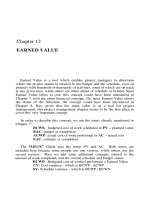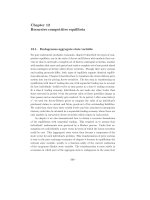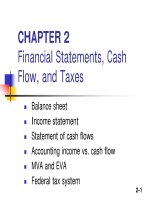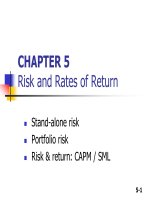Slide Financial Management - Chapter 12 ppsx
Bạn đang xem bản rút gọn của tài liệu. Xem và tải ngay bản đầy đủ của tài liệu tại đây (93.07 KB, 21 trang )
12-1
CHAPTER 12
Other Topics in Capital Budgeting
Evaluating projects with unequal lives
Identifying embedded options
Valuing real options in projects
12-2
Evaluating projects with
unequal lives
Projects S and L are mutually exclusive, and will
be repeated. If k = 10%, which is better?
Expected Net CFs
Year Project S Project L
0 ($100,000) ($100,000)
1 59,000 33,500
2 59,000 33,500
3 - 33,500
4 - 33,500
12-3
Solving for NPV,
with no repetition
Enter CFs into calculator CFLO register for
both projects, and enter I/YR = 10%.
NPV
S
= $2,397
NPV
L
= $6,190
Is Project L better?
Need replacement chain analysis.
12-4
-100,000 59,000 59,000 59,000 59,000
-100,000
-41,000
Replacement chain
Use the replacement chain to calculate an
extended NPV
S
to a common life.
Since Project S has a 2-year life and L has a
4-year life, the common life is 4 years.
0 1 2 3
10%
4
NPV
S
= $4,377 (on extended basis)
12-5
What is real option analysis?
Real options exist when managers can
influence the size and riskiness of a
project’s cash flows by taking different
actions during the project’s life.
Real option analysis incorporates
typical NPV budgeting analysis with an
analysis for opportunities resulting
from managers’ decisions.
12-6
What are some examples of
real options?
Investment timing options
Abandonment/shutdown options
Growth/expansion options
Flexibility options
12-7
Illustrating an investment
timing option
If we proceed with Project L, its annual cash
flows are $33,500, and its NPV is $6,190.
However, if we wait one year, we will find
out some additional information regarding
output prices and the cash flows from
Project L.
If we wait, the up-front cost will remain at
$100,000 and there is a 50% chance the
subsequent CFs will be $43,500 a year, and
a 50% chance the subsequent CFs will be
$23,500 a year.
12-8
Investment timing decision tree
At k = 10%, the NPV at t = 1 is:
$37,889, if CF’s are $43,500 per year, or
-$25,508, if CF’s are $23,500 per year, in
which case the firm would not proceed with
the project.
50% prob.
50% prob.
01234 5
Years
-$100,000 43,500 43,500 43,500 43,500
-$100,000 23,500 23,500 23,500 23,500
12-9
Should we wait or proceed?
If we proceed today, NPV = $6,190.
If we wait one year, Expected NPV at
t = 1 is 0.5($37,889) + 0.5(0) =
$18,944.57, which is worth
$18,944.57 / (1.10) = $17,222.34 in
today’s dollars (assuming a 10%
discount rate).
Therefore, it makes sense to wait.
12-10
Issues to consider with
investment timing options
What’s the appropriate discount rate?
Note that increased volatility makes the option to
delay more attractive.
If instead, there was a 50% chance the
subsequent CFs will be $53,500 a year, and a
50% chance the subsequent CFs will be
$13,500 a year, expected NPV next year (if we
delay) would be:
0.5($69,588) + 0.5(0) = $34,794 > $18,944.57
12-11
Factors to consider when
deciding when to invest
Delaying the project means that cash
flows come later rather than sooner.
It might make sense to proceed
today if there are important
advantages to being the first
competitor to enter a market.
Waiting may allow you to take
advantage of changing conditions.
12-12
Abandonment/shutdown option
Project Y has an initial, up-front cost of
$200,000, at t = 0. The project is
expected to produce after-tax net cash
flows of $80,000 for the next three years.
At a 10% discount rate, what is Project Y’s
NPV?
01 23
-$200,000 80,000 80,000 80,000
k = 10%
NPV = -$1,051.84
12-13
Abandonment option
Project Y’s A-T net cash flows depend
critically upon customer acceptance of
the product.
There is a 60% probability that the
product will be wildly successful and
produce A-T net CFs of $150,000, and
a 40% chance it will produce annual
A-T net CFs of -$25,000.
12-14
Abandonment decision tree
If the customer uses the product,
NPV is $173,027.80.
If the customer does not use the product,
NPV is -$262,171.30.
E(NPV) = 0.6(173,027.8) + 0.4(-262,171.3)
= -1,051.84
-$200,000
60% prob.
40% prob.
1 2 3
Years
0
150,000 150,000 150,000
-25,000 -25,000 -25,000
12-15
Issues with abandonment options
The company does not have the
option to delay the project.
The company may abandon the
project after a year, if the customer
has not adopted the product.
If the project is abandoned, there
will be no operating costs incurred
nor cash inflows received after the
first year.
12-16
NPV with abandonment option
If the customer uses the product,
NPV is $173,027.80.
If the customer does not use the product,
NPV is -$222,727.27.
E(NPV) = 0.6(173,027.8) + 0.4(-222,727.27)
= 14,725.77
-$200,000
60% prob.
40% prob.
1 2 3
Years
0
150,000 150,000 150,000
-25,000
12-17
Is it reasonable to assume that the
abandonment option does not affect
the cost of capital?
No, it is not reasonable to assume
that the abandonment option has
no effect on the cost of capital.
The abandonment option reduces
risk, and therefore reduces the cost
of capital.
12-18
Growth option
Project Z has an initial up-front cost of
$500,000.
The project is expected to produce A-T cash
inflows of $100,000 at the end of each of the
next five years. Since the project carries a 12%
cost of capital, it clearly has a negative NPV.
There is a 10% chance the project will lead to
subsequent opportunities that have an NPV of
$3,000,000 at t = 5, and a 90% chance of an
NPV of -$1,000,000 at t = 5.
12-19
NPV with the growth option
100,000 100,000 100,000 100,000 100,000
-$500,000
10% prob.
90% prob.
1234 5
Years
0
100,000 100,000 100,000 100,000 100,000
-$1,000,000
$3,000,000
At k = 12%,
NPV of top branch (10% prob) = $1,562,758.19
NPV of lower branch (90% prob) = -$139,522.38
12-20
NPV with the growth option
If it turns out that the project has future
opportunities with a negative NPV, the company
would choose not to pursue them.
Therefore, the NPV of the bottom branch should
include only the -$500,000 initial outlay and the
$100,000 annual cash flows, which lead to an NPV
of -$139,522.38.
Thus, the expected value of this project should be:
NPV = 0.1($1,562,758) + 0.9(-$139,522)
= $30,706.
12-21
Flexibility options
Flexibility options exist when it’s
worth spending money today, which
enables you to maintain flexibility
down the road.









